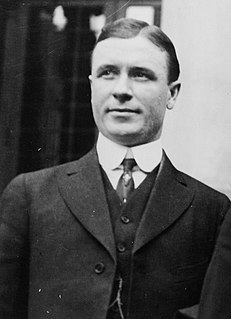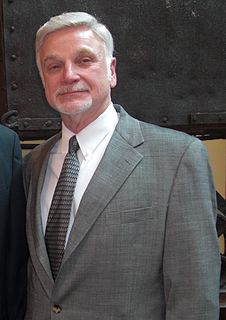
John Llewellyn Lewis was an American leader of organized labor who served as president of the United Mine Workers of America (UMW) from 1920 to 1960. A major player in the history of coal mining, he was the driving force behind the founding of the Congress of Industrial Organizations (CIO), which established the United Steel Workers of America and helped organize millions of other industrial workers in the 1930s, during the Great Depression. After resigning as head of the CIO in 1941, Lewis took the United Mine Workers out of the CIO in 1942 and in 1944 took the union into the American Federation of Labor (AFL).

The United Mine Workers of America is a North American labor union best known for representing coal miners. Today, the Union also represents health care workers, truck drivers, manufacturing workers and public employees in the United States and Canada. Although its main focus has always been on workers and their rights, the UMW of today also advocates for better roads, schools, and universal health care. By 2014, coal mining had largely shifted to open pit mines in Wyoming, and there were only 60,000 active coal miners. The UMW was left with 35,000 members, of whom 20,000 were coal miners, chiefly in underground mines in Kentucky and West Virginia. However it was responsible for pensions and medical benefits for 40,000 retired miners, and for 50,000 spouses and dependents.

William Julian Usery Jr. was a labor union activist and U.S. government political appointee who served as United States Secretary of Labor in the Ford administration.

Philip Murray was a Scottish-born steelworker and an American labor leader. He was the first president of the Steel Workers Organizing Committee (SWOC), the first president of the United Steelworkers of America (USWA), and the longest-serving president of the Congress of Industrial Organizations (CIO).

The Coal strike of 1902 was a strike by the United Mine Workers of America in the anthracite coalfields of eastern Pennsylvania. Miners striked for higher wages, shorter workdays, and the recognition of their union. The strike threatened to shut down the winter fuel supply to major American cities. At that time, residences were typically heated with anthracite or "hard" coal, which produces higher heat value and less smoke than "soft" or bituminous coal.
The Progressive Miners of America was a coal miners' union organized in 1932 in downstate Illinois. It was formed in response to a 1932 contract proposal negotiated by United Mine Workers President John L. Lewis, which reduced wages from a previous rate of $6.10 per day to $5.00 per day.
The Canadian Mineworkers Union (CMU) was a Canadian trade union of coal miners based in Cape Breton Island, Nova Scotia. Although it never won an election or legally represented workers, it was part of an important movement among Canadian unions in the 1980s to break away from their international American counterparts.
The Bituminous coal strike of 1974 was a 28-day national coal strike in the United States led by the United Mine Workers of America, AFL-CIO. It is generally considered a successful strike by the union.
The Bituminous coal strike of 1977–1978 was a 110-day national coal strike in the United States led by the United Mine Workers of America, AFL-CIO. It began December 6, 1977, and ended on March 19, 1978. It is generally considered a successful union strike, although the contract was not beneficial to union members.
Arnold Miller was a miner and labor activist who served as president of the United Mine Workers of America (UMWA), AFL-CIO, from 1972 to 1979. Winning as a reform candidate, he gained positive changes for the miners, including compensation for black lung disease. He had difficulty dealing with growing internal union opposition. His last two years as president were particularly tumultuous and he suffered two heart attacks, finally resigning in November 1979 with the title of "president emeritus for life".

Frank J. Hayes was an American miner and president of the United Mine Workers of America (UMWA) from 1917 to 1919. A Democrat, he also served as Lieutenant Governor of Colorado in 1937–39.
Samuel Morgan Church, Jr. was a coal miner and president of the United Mine Workers of America (UMWA) from 1979 to 1982.

Cecil Roberts is a miner and president of the United Mine Workers of America (UMWA). He is also sits on the AFL–CIO's executive council. Roberts is the great-grandson of Ma Blizzard.
The Westmoreland County coal strike of 1910–1911, or the Westmoreland coal miners' strike, was a strike by coal miners represented by the United Mine Workers of America. The strike is also known as the Slovak Strike because about 70 percent of the miners were Slovak immigrants. It began in Westmoreland County, Pennsylvania, on March 9, 1910, and ended on July 1, 1911. At its height, the strike encompassed 65 mines and 15,000 coal miners. Sixteen people were killed during the strike, nearly all of them striking miners or members of their families. The strike ended in defeat for the union.
Phil Penna was an American labor leader, and president of the United Mine Workers of America (UMWA) from 1895 to 1896.
The Cape Breton coal strike of 1981 was a strike by coal miners who were members of the United Mine Workers of America against the Cape Breton Development Corporation (DEVCO) of Cape Breton Island, Nova Scotia, Canada. The strike, which was bitter and violent, began in the middle of July 1981, and ended in early October of that year.
The Pittston Coal strike was a United States strike action led by the United Mine Workers Union (UMWA) against the Pittston Coal Company, nationally headquartered in Pittston, Pennsylvania. The strike, which lasted from April 5, 1989 to February 20, 1990, resulted from Pittston's termination of health care benefits for approximately 1,500 retirees, widows, and disabled miners. The strikers also cited the refusal of the company to contribute to the benefit trust established in 1950 for miners who retired before 1974 and the refusal of the company to bargain in good faith as grounds for their action. The company cited declining coal prices, decreasing demand, and recession as its reason for limiting health care benefits.
The 1927 Indiana bituminous strike was a strike by members of the United Mine Workers of America (UMWA) against local bituminous coal companies. Although the struggle raged throughout most of the nation's coal fields, its most serious impact was in western Pennsylvania, including Indiana County. The strike began on April 1, 1927, when almost 200,000 coal miners struck the coal mining companies operating in the Central Competitive Field, after the two sides could not reach an agreement on pay rates. The UMWA was attempting to retain pay raises gained in the contracts it had negotiated in 1922 and 1924, while management, stating that it was under economic pressure from competition with the West Virginia coal mines, was seeking wage reductions. The strike proved to be a disaster for the union, as by 1929, there were only 84,000 paying members of the union, down from 400,000 which belonged to the union in 1920.
The Roving Picket Movement was the culmination of years of unrest from mine workers about their working conditions in the Appalachian region. The movement lasted from 1959 to 1965, with goals of reinstating health benefits and improving working conditions. Miners protested at several mines in Eastern Kentucky, and laid and the foundation for future movements within the Appalachian coal community.
The Coal Employment Project (CPE) was a non-profit women's organization from 1977–1996 with the goal of women gaining employment as miners. With local support groups in both the eastern and western coalfields, CEP also advocated for women on issues such as sexual harassment, mine safety, equal access to training and promotions, parental leave, and wages.






